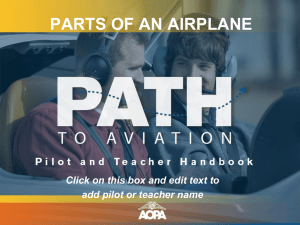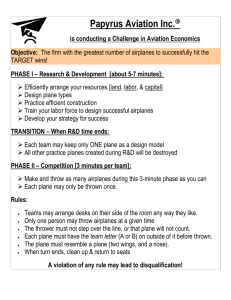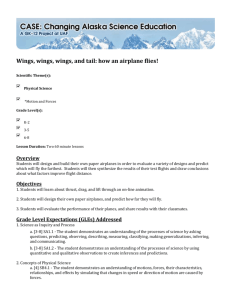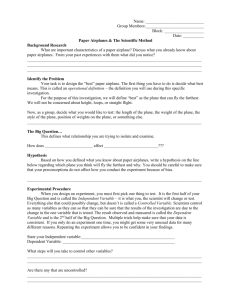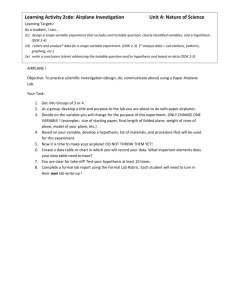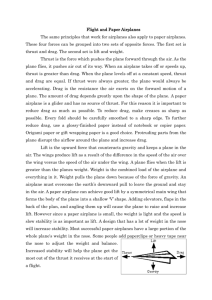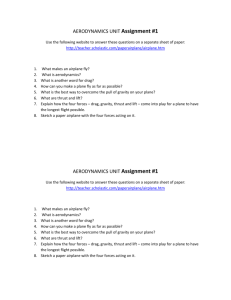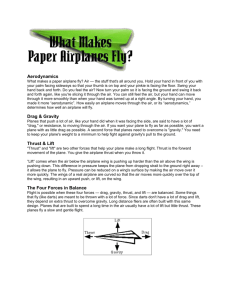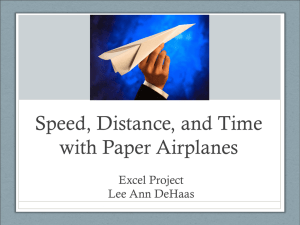Contents
advertisement
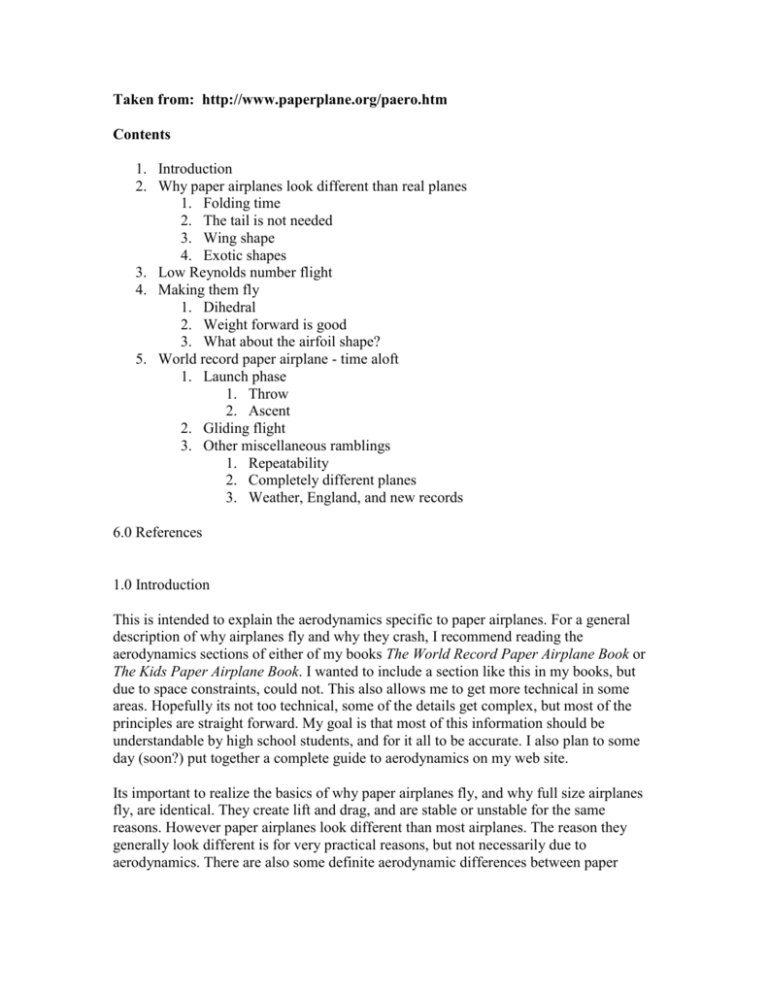
Taken from: http://www.paperplane.org/paero.htm Contents 1. Introduction 2. Why paper airplanes look different than real planes 1. Folding time 2. The tail is not needed 3. Wing shape 4. Exotic shapes 3. Low Reynolds number flight 4. Making them fly 1. Dihedral 2. Weight forward is good 3. What about the airfoil shape? 5. World record paper airplane - time aloft 1. Launch phase 1. Throw 2. Ascent 2. Gliding flight 3. Other miscellaneous ramblings 1. Repeatability 2. Completely different planes 3. Weather, England, and new records 6.0 References 1.0 Introduction This is intended to explain the aerodynamics specific to paper airplanes. For a general description of why airplanes fly and why they crash, I recommend reading the aerodynamics sections of either of my books The World Record Paper Airplane Book or The Kids Paper Airplane Book. I wanted to include a section like this in my books, but due to space constraints, could not. This also allows me to get more technical in some areas. Hopefully its not too technical, some of the details get complex, but most of the principles are straight forward. My goal is that most of this information should be understandable by high school students, and for it all to be accurate. I also plan to some day (soon?) put together a complete guide to aerodynamics on my web site. Its important to realize the basics of why paper airplanes fly, and why full size airplanes fly, are identical. They create lift and drag, and are stable or unstable for the same reasons. However paper airplanes look different than most airplanes. The reason they generally look different is for very practical reasons, but not necessarily due to aerodynamics. There are also some definite aerodynamic differences between paper airplanes and full size planes. These difference are not so apparent, but do affect how paper airplanes fly. 2.0 Why Paper Airplanes Look Different Than Real Planes Most full size planes have wings, a tail, and a fuselage (body) that holds the pilot and passengers. Most paper airplanes have just a wing and fold of paper on the bottom that you hold when you throw the plane. There are several reasons for the differences. 2.1 Folding time The main reason why paper airplanes look different than real planes is to allow the paper airplane constructor to make a plane as easily and quickly as possible. Adding a tail and any other pieces to a paper airplane would require more folds, and probably scissors, tape and glue. The simplest airplane is the flying wing, and that's what most paper airplanes are. 2.2 The Tail Is Not Needed The horizontal tails on full size planes have an elevator (control surface across the back edge of the horizontal tail) which the pilot rotates (back edge) up to make the plane nose up and fly slower, or down to nose the plane down and speed up. Paper airplanes accomplish the same thing by bending the back edge of the wing up to fly slower, of down to fly faster. Several full size airplanes have been flown successfully without tails. The Northrop XB35 and B-2, and the sailplanes of the Horton brothers were all stable, good flying airplanes. Many people assume a tail is needed for stability - but the above mentioned planes, and millions of paper airplanes prove different! B-2 Flying wing bomber The horizontal tail of a plane allows the weight to move forward and aft more while remaining stable and controllable. Where a plane balances if it were supported at only one point is called the Center of Gravity (CG). The CG can move further forward or aft due to different passenger and cargo loadings, and due to fuel burn (most jets carry about half their empty weight in fuel). All airplanes become unstable if the CG moves aft of a point called the Neutral Point. As the CG moves forward of the neutral point, the plane gets progressively more stable, and progressively needs more up elevator. Elevators on tails can be more effective than elevators on the back of wings, so planes with tails can have a greater CG range than planes without tails. With paper airplanes their CG does not move, so they are fine without a tail. A tail is also needed to balance the pitching moment (tendency to make the plane rotate nose up or down) caused by flaps. Flaps are the control surfaces on the back edge of the wing which are deflected down to allow the plane to takeoff and land slower. Paper airplanes do not need to fly any slower, so they do not need flaps, or the tail needed to balance the flaps. The tail of a real plane usually also has a vertical tail. The vertical tail acts like the fins of an arrow to keep the nose of the plane pointed in the direction its headed, this is called positive directional stability. The Fuselage (center body of a plane, on paper airplanes its the part you hold for throwing) acts like the vertical stabilizer of real airplanes. Sometimes bending the wingtips up on paper airplanes also helps to add directional stability. The combination of the fuselage and wingtips on paper airplanes allows them to have positive directional stability without a vertical tail. 2.3 Wing Shape Paper airplanes usually have short "stubby" wings, called "low aspect ratio" wings. The distance from wing tip to wing tip is called wing span, and the distance from the front to the back of the wing is called the chord. The ratio of wing span to average chord is called "aspect ratio", and is an important characteristic of wings. For subsonic (less than the speed of sound) airplanes wing drag is reduced by increasing wing span and decreasing wing chord, both increase the aspect ratio. For that reason aspect ratio is a good indicator of overall wing drag. Notice that sailplane(glider) designers are extremely concerned with wing drag, and use high aspect ratio (big wing span, narrow chord) wings. Getting back to paper airplanes, or more correctly paper gliders, notice their wing shape is much different from real gliders because they have low aspect ratio wings. There are several good reasons for this difference. 1. Paper is a lousy building material. There is a reason why real airplanes are not made of paper. Although high aspect ratio wings reduce drag, they also require better building materials. The low strength of paper does not allow the use of high aspect ratio wings. 2. Low aspect ratio wings are easier to fold. One of the reasons we make paper airplanes is because they are fast and easy to build (gee, is that two reasons?). 3. Paper airplane gliding performance is not usually very important. We usually want a plane that does a good job of flying across the room, and aren't too concerned if another paper airplane design (which would be more difficult to build) could have made the same flight more gracefully. Notice that for my world record paper airplane gliding performance is extremely important, but a low aspect ratio wing is needed to withstand the high launch speed (more on the specifics of the world record plane later). 4. Low aspect ratio wings look faster, especially if they are swept back. People associate low aspect ratio, swept back wings with low drag, high speed fighters. In reality if an airplane is flying less than 500 miles per hour it will have lower drag with a straight, high aspect ratio wing. This seems confusing to many. Think of it this way, if low aspect ratio swept back wings had the lowest drag for all planes, all planes would have them. Airplanes flying from 500-600 mph have the lowest drag with fairly high aspect ratio swept back wings. That is why jet airliners have that kind of wing. Airplanes that fly over 600 mph, like jet fighters and the Concorde, really do have the lowest drag with low aspect ratio swept back wings. However the truth doesn't change the fact that low aspect ratio swept wings look fast, and that's OK. LS-6 Sailplane 2.4 Exotic Shapes Real airplanes have to be optimized to perform some mission. Since its tough to beat the basic wing/fuselage/tail configuration for aerodynamic efficiency, most planes look that way. The mission of a paper airplane is to provide a good time for the pilot. Sometimes that means the amazement of seeing something radical fly through the air. The combinations of wings, tails, fuselages, and other parts that can be made to fly is endless. Beyond the traditional paper airplane designs there are many exotic shapes that don't look like they should fly. One of these is the "hoop shape", known as the Vortex in my original book. Another exotic shape is in my 1997 calendar called the X-Plane. It is basically two wings attached in the middle and at different angles to form an "X" shape. Other more familiar shapes, but not thought of as airplanes, can also be made to fly. One of these is the Starship from my 1997 calendar, which looks like a futuristic space craft, but it actually flies. With paper airplanes its easy to make airplanes that don't look like real airplanes. 3.0 Low Reynolds Number Flight Paper airplanes are smaller and fly slower than most other aircraft. So how does that affect their aerodynamics? Back in 1883 Osborne Reynolds, professor of engineering at the University of Manchester (England) carried out experiments to determine why fluid forces through pipes changed for different conditions. Basically what he discovered is how viscosity affects the way fluids behave. All fluids (a fluid is anything that flows - air, water, maple syrup, …) have some viscosity, or stickiness, to them. As a fluid flows over a surface, the fluid molecules closest to the surface cling to the microscopic roughness of the surface. As you move away from the surface there is a small transition distance where the fluid's viscosity limits the change in speed of the adjacent molecules, until at a certain distance the fluid is at full speed. The narrow region near the surface where the fluid is less than full speed is called the boundary layer. All boundary layers start as "laminar" where the molecules travel in a straight line, with a smooth transition in fluid velocity from the surface to the outer edge of the boundary layer. Further downstream disturbances and waves form in the boundary layer and transition the smooth orderly laminar boundary layer into a "turbulent" boundary layer. Turbulent boundary layers have a laminar sub-layer next to the surface, but are mainly characterized by swirling random eddies throughout the boundary layer. A number was devised which gives the relative importance of viscosity in fluid flow. It is called the Reynolds Number, and it is the ratio of momentum forces to viscous forces in a fluid. The bigger the number, the less influential the viscosity. The viscosity is essentially a constant for a fluid (it changes a bit with temperature), but momentum is proportional to the speed of a fluid over a surface times the distance it has traveled over the surface. For air it is roughly: Re=K*V*L Re=Reynolds number (non-dimensional) K=9340 V=Velocity relative to surface (miles per hour) L=Length over surface fluid has traveled (feet) So for a paper airplane (remember, this is about paper airplanes) Re=9340*10*.4=37,000 By comparison the wings of a four passenger airplane have a Reynolds Numbers of up to about 6,000,000. Also, remember the transition from laminar to turbulent? That happens at a Reynolds number of no less than about 10,000, so the first ½ to ¼ of the flow over a paper airplane's wing is laminar. Since the Reynolds Number is much less than for full sized airplanes, this means viscosity is much more dominant, resulting in more drag, and more difficulty in creating lift. The low Reynolds Number of paper airplanes also means thin wings are best. As wings get thicker, the air has to work harder to make it around the airfoil. At high Reynolds numbers with turbulent boundary layers this is easy. At low Reynolds Numbers and laminar boundary layers, this is very difficult. If a thick (say 10% of chord or more) airfoil is used on a paper airplane, the air cannot make it around the airfoil and separates about midway across the wing resulting in huge amounts of drag, and little lift - the paper airplane won't fly. I try to keep my wings no thicker than about 3% to 5% of the chord length, so its important to fold your wings nice and flat. Mother nature knows this. Birds fly faster than paper airplanes, and they have thick curved airfoils. Insects are closer in Reynolds number to paper airplanes, and they have thin flat wings - look at a butterfly's wings some time. 4.0 Making Them Fly The "secrets" to making paper airplanes fly well are largely the same adjustments which make hand launched gliders fly well. Most people have the unfortunate idea that a good paper airplane needs no adjustments after the basic folds are finished. All real airplanes have trim tabs to make small adjustments to the plane, and all paper airplanes need small adjustments to fly their best. There are a few basic adjustments and principles which will transform the paper airplane novice into a paper airplane expert. The following flying tips are generally covered in my books, but I go into a little more detail here. 4.1 Dihedral One of the most common paper airplane mistakes is to leave the wings folded down at an angle. That is called "anhedral", and it reduces the lateral stability of your paper airplane. What you want is called "dihedral" which is when the wing tips are the highest part of the wing. The resulting lateral stability will help keep your paper airplane flying straight, or perhaps in a gradual turn. With lateral instability your paper airplane will either roll over on its back and crash, or enter into an ever tightening spiral which becomes a spiraling dive. Just remember - keep your wing tips up. Technically dihedral provides a stabilizing rolling moment due to sideslip. For example if the plane yaws to the left (positive sideslip), the right wing has a slightly increased angle of attack (AOA) because of the dihedral, while left wing's AOA is decreased (this is most easily imagined if you think about 90 degrees of sideslip). The resulting rolling moment is to the left, which is stabilizing. During a level turn, the yaw rate combined with the stabilizing yawing moment due to yaw rate results in a little bit of sideslip, positive for right turns, negative for left. That small amount of sideslip together with a stabilizing rolling moment due to sideslip (dihedral effect) results in the plane wanting to roll out of the turn. With anhedral, the plane wants to roll into the turn, resulting in a "graveyard spiral". The tendency to roll into or out of a turn is called the spiral mode, which is controlled mainly using dihedral. Most real airplanes have to limit the amount of dihedral they use to keep the Dutch roll mode, a rapid left and right oscillation, under control. While dihedral makes the spiral mode more stable, it reduces the damping of the Dutch roll. I have rarely witnessed any Dutch roll problems with paper airplanes, likely due to increased yaw rate and roll rate damping associated with low airspeeds. As a result all paper airplanes should be flown with plenty of dihedral. 4.2 Weight Forward is Good As mentioned in section 2.2, where a paper airplane balances is called the Center of Gravity (CG), and there is a specific CG position known as the Neutral Point which provides neutral pitch stability. If the airplane has a CG ahead of this point, the plane is stable, if its behind this point its unstable. Naturally all airplanes without computer assisted flight controls need a CG ahead of their neutral point. For rectangular wings the neutral point is ¼ of the distance from the nose to the tail. For delta wings (such as the common dart paper airplane) the neutral point is ½ of the distance from the nose to the tail. Stability means the plane, if disturbed, will return to its original state. For pitch stability it means the plane will seek a single airspeed. A plane which is unstable in pitch will either pitch up into a stall, or nose dive, but won't settle out anywhere in between. A stable airplane will tend to oscillate up and down a few times, but converge on a steady flight speed. Many typical paper airplane designs are stable, but just barely. As a plane becomes more and more stable, it wants to fly faster and faster. To counter this tendency, up elevator must be used to produce a good trim airspeed. This is why many of the classic paper airplane designs are nearly neutrally stable. Few people realize good pitch stability requires a heavy nose and some up elevator. The classic designs rely on the small inherent "up elevator" effect (positive zero lift pitching moment) resulting from the swept wing, and possibly the airfoil shape. Thus many classic paper airplanes can be flown with no elevator adjustment. Sometimes they fly well, many times they don't, and they always have poor stability. I like to add a tiny amount of up elevator to the classic pointed nose paper airplanes, to make sure they don't dive. If I have the time and materials, I like to add a few layers of tape or a paper clip to the nose of the plane to improve its stability. Most "square" paper airplanes have plenty of weight in the nose, and require some up elevator to fly well. Actually the amount of up elevator needed on a paper airplane is a good indicator of its pitch stability. Build a paper airplane (any kind) and place a paper clip on the nose. Make a few flights to determine the best amount of up elevator needed. Now move the paper clip back an inch or two, and repeat. The amount of up elevator needed is reduced, and the plane becomes more sensitive to elevator adjustments. When the paper clip has been moved back to a point where you are using nearly no elevator deflection, and you can't get the plane to fly well, you have the CG at the neutral point (try to balance the plane on a finger, the point where it balances is the neutral point). 4.3 What about the airfoil shape? Most people who are reading this know that airplane wings are "Cambered" which means they have generally a curved shape, with the top of the airfoil rounded and the bottom fairly flat. As explained in section 3.0, paper airplane wings must be thin to work well. In addition, they need very little camber, and generally any curvature is limited to the front portion of the wing. I have had people ask me why I don't advocate cambered airfoils for paper airplanes in my books. Since most paper airplanes are flying wings, only small amounts of camber are practical, as large amounts of camber create nose down pitching moments which need tails to balance. Generally I do use a little curvature at the leading edge of the wing. I have noticed that paper airplane performance is not noticeably degraded with flat, uncambered airfoils. The reason for this is likely due to low Reynolds numbers. Remember that a large portion of the boundary layer across the front of the wing is laminar flow, but for high lift we need a turbulent boundary layer. The use of a flat uncambered wing produces a large pressure gradient at the leading edge, which likely aids the transition to a turbulent boundary layer, which could likely be the reason for little camber in insect wings. Also, swept wings with uncambered leading edges promote vortex flow just behind the leading edge on the upper surface. Although lift coefficients at these Reynolds numbers aren't large enough to promote a large amount of vortex lift(vortex lift increases exponentially with lift coefficient), any vortex flow likely helps the transition to a turbulent boundary layer. 5.0 World Record Paper Airplane - Time Aloft I developed the world record paper airplane when I was about 13 years old, and I'm still trying to figure out exactly how it works. I was trying to "invent" new types of paper airplanes, combining folds from different types of paper planes. This particular plane started with a couple of folds from a pointed paper plane, then square paper plane folds, and finally adding wing tip fins (I had read about winglets, and wanted to add them to the plane). When I flew it outside, it flew higher and longer than my previous planes. I liked to fly paper airplanes outside, and I began using the new plane as I could launch it very high to catch rising air currents. It wasn't until I looked through a Guinness Book of Records a year or two later that I realized its potential ability to break the record. At that point I began improving the plane, and my throw, in order to challenge the record. I feel lucky that my efforts have paid off, but I am still learning why it works the way it does, and improving the plane and the throw. Over the 20+ year span life of this paper airplane, the folds have changed only a little, but the fine tuning bends and tweaks keep changing as I learn more about aerodynamics, and as the plane teaches me more about aerodynamics. Its important to realize this paper airplane's mission is to stay in the air for as long as possible. It accomplishes this in two distinct phases which have many conflicting aerodynamic characteristics. The first phase is the launch phase, where I throw it vertically at 60 miles per hour, and it ascends vertically to about 60 feet. It slows to nearly a stop (sometimes it really does stop and then tail slides), then begins the second phase of slow steady gliding flight. The first phase lasts about 3 seconds, the second about 17 (on a world record throw). Here are some of the conflicting aerodynamic drivers: Launch phase Short wings better Trim at zero lift Heavy better (thick paper) Gliding flight Long wings better Trim at high lift Light better (thin paper) Time aloft for a paper airplane can be optimized by either throwing a paper airplane with a short wing span real high, and having it glide downward fairly quickly (what I do), or making a fragile long wing span plane and launching it gently from as high as you can reach, or something in between. The primary tradeoff is wingspan - short wings can withstand a fast throw, but don't glide so well. Long wings glide great, but can't be thrown hard. I have seen paper airplanes made from one sheet of paper which had wing spans of 3 feet, and descended at only 6 inches a second (1/6 the vertical speed of mine). A basketball player with a vertical reach to 10 feet could seriously challenge my record. I think better flight times, and for me more fun is had, with the smaller swifter planes. 5.1 Launch phase The trick is to get the paper airplane gliding from as high as possible. To achieve this I launch the plane as fast as possible, straight up. As it ascends the force of gravity and the force of drag slow it down until it stops. From there the plane's natural stability ensures it begins slow gliding flight. 5.1.1 Throw Throwing anything straight up is not entirely natural. For maximum height and for a good transition to gliding flight, the throw must be within 10 degrees of vertical. Also for maximum height, the throw must be as fast as possible. I used some of the principles of biomechanics (science of the mechanics of the body ) together with baseball throwing techniques and shot put throwing techniques to develop the throw I use. I would like to thank my high school coach Mike Lauten for enrolling me in his biomechanics class. I estimate the plane leaves my hand at 60 miles per hour. This is based on two independent methods. First, I have had my baseball pitches clocked with a speed gun at about 65 miles per hour, and I think my paper airplane throws are about the same speed. The second method was mathematical. Knowing the plane reaches a height of from 50 to 60 feet, and the drag coefficient of the plane, I determined the launch energy required (kinetic, .5*mass*v*v) to equal the potential energy (weight*height) plus drag energy (integrated drag*velocity over the launch time), the resulting launch speed was about 60 miles per hour. 5.1.2 Ascent A major reason why the world record plane is successful is the ascent. During the ascent the plane's angle of attack is near zero, resulting in near zero lift and allowing the plane to go virtually straight up. This is crucial for two reasons. In slow flight the plane is adjusted to produce a lift coefficient of about 0.7. If the plane were rigid, it would trim to the same lift coefficient at all speeds, with a sharp pull up into a loop at speeds higher than 10 mph. At the speed I launch it, it should enter into a 40 g loop, but it doesn't. The second reason zero lift is important is because of drag. If the plane stayed at its 0.7 lift coefficient, it would more than double the drag during the ascent and not allow the plane to climb high enough for a record flight (roughly 50% of the kinetic energy from the throw is used to overcome drag, the other 50% is converted into potential energy in the form of altitude). The plane does not go to exactly zero lift, and spirals a bit during the ascent to maintain a near vertical trajectory. Sometimes I have to add some rudder deflection to aid the spiraling to improve the ascent. I have also experimented with introducing intentional asymmetries into the plane to aid spiraling. So why and how does the plane go to near zero lift? I'm not really certain, but I think I have the answer. As I said, it would trim to a 0.7 lift coefficient and enter a 40 g loop if it were rigid, but it isn't rigid. I suspect the reflexed section (the up elevator) to pushes the rear portion of the wing down, producing a more curved airfoil which wants to pitch the nose down and trim at a lower lift coefficient. Also the weight of the fuselage at the middle of the plane results in a large root bending moment as the plane pulls g's, so that the wings flex upward (added dihedral) which effectively lowers the angle of attack and lift coefficient the plane ascends at, with the wings returning to their original dihedral as the plane slows. I need to take some high speed video to analyze what happens during the launch. The airfoil of the plane also affects the launch. I have tried using highly cambered airfoils optimized for slow gliding, but they tend to degrade the ascent. I wrote a computer program to reproduce the flight of the world record paper airplane to learn what parameters were most important for a long flight. One of the most important things I learned was that Cdo, zero lift wing drag, is more important in the ascent than it is in the descent. The airfoil optimized for slow gliding is not optimized for zero lift, and produces extra drag during the ascent. What is needed is an airfoil which produces low drag during slow, high lift flight, but more importantly has low drag during the ascent. I believe a nearly flat, uncambered airfoil does this. Certainly a flat airfoil is ideal for low drag at zero lift, but it can work at higher lift coefficients also. The flat wing at high lift results in a steep pressure gradient near the front of the wing on the upper surface, which likely aids transition to a turbulent boundary layer which is needed for low drag at high lift. I plan to do more airfoil tests during the spring of '97 to help find the best airfoil for long flight. I have found pitch stability to be important also. The plane not only needs to be stable, but it needs to have just the right amount of stability. Pitch stability is controlled by how nose heavy the plane is, and that is controlled by the size and number of folds down the sheet of paper. The flexibility effects apparently only produce a small change in pitching moment, so the stability must be fairly weak to allow a significant change in trim angle of attack. Too little stability results in erratic gliding flight, with frequent stalls as the plane drifts slower than the desired angle of attack. One way to improve gliding stability is to tighten the turn radius. As a plane circles in flight it introduces a pitch rate. Natural pitch damping tends to try to nose the airplane down with positive pitch rate. As pitch rate increases with angle of attack, so does the nose down pitching moment due to pitch rate, thus providing added pitch stability to the plane. The tighter the circling, the better the stability. A drawback to this scheme is the increased load factor, and degraded gliding performance as the plane circles more tightly. Many times I set the circle size, by adjusting the rudder deflection, just small enough to keep the plane from porpoising (pitching up and down) into a stall. Generally circles less than 20 or 30 feet in diameter noticeably increase sink rate. 5.2 Gliding Flight The goal for gliding flight is to descend vertically as slowly as possible. This represents the lowest rate of change of potential energy(power) which is the minimum product of drag times velocity. Generally the minimum sink rate for gliders is just above stall, and that's true for paper airplanes as well. For those interested in the details and math, finding the minimum power required involves taking the equation for powered required, differentiating with respect to velocity, and setting this equal to zero (standard calculus procedure for finding the minimum or maximum of a function. Starting with the basic parabolic drag curve; D=.5 * rho * v*v * S * ( Cdo + Cl*Cl/(pi*e*AR)) D=drag in pounds rho=air density (slugs per cubic foot, .002377 at sea level) v=paper airplane velocity (ft/sec) S=wing area (square ft, .234 for world record plane) Cdo=Drag coefficient at zero lift (about .07) Cl=lift coefficient (about .7 for minimum sink) pi=3.1415 e=span efficiency factor, estimate .7 AR=span/average chord=7.5"/4.5"=1.67 Converting Cl in terms of v (cl=2*wt/(rho*v*v*S)) wt=weight (lb, .01 for a sheet of paper) and multiplying times v yields Power=P=.5*rho*v*v*v*S*Cdo + 2*wt*wt/(pi*e*b*b*rho*v) (ft-lb/s) b=span, ft Differentiate, set equal to zero, yields Cl=sqrt(3*Cdo*pi*e*AR) and therefor v=sqrt(2*wt/(rho*S*sqrt(3*Cdo*pi*e*AR))) This gives a lift coefficient and airspeed for minimum sink rate of about .7, and 8.4 ft/s (6 mph) Substituting the minimum sink results into the power equation, and knowing that vertical velocity is power/weight, gives the following: Min Vert Velocity=Vvmin=1.05*(rho**-.5)(f**.25)(wt**.5)(e**-.75)(b**-1.5) (ft/sec) f=Cdo*S This equation gives the minimum vertical velocity of paper airplanes, sailplanes, 747s, ... For the world record paper airplane this gives a minimum sink speed of about 2.5 ft/sec Note that the main drivers for sink speed are weight and wing span, and to a lesser amount on f. The weight is determined by the thinnest paper which can withstand the launch throw, which is about 24 pound paper, which is about .01 pounds per sheet. The wing span of the world record plane is about 7.5 inches, and is limited by the launch speed (longer spans become too "floppy", and cannot hold a reasonable dihedral angle after the launch phase). "f" is determined by Cdo, and I have worked quite a bit on this parameter. I have to be careful when adjusting the elevator deflection for my plane, to trim it near, but not past the stall angle of attack (determined by throwing, readjusting, throwing... until it looks right). During the fall of '96 I decided to try to design a better airfoil section for my plane to decrease the Cdo. I used the PROFOIL program(see my aeronautical engineering links) to design several candidate airfoils. The new airfoil shape seemed to work. Previously only a small fraction of the planes I build really seam to "float", many sink at over 3 or even 4 feet per second (for a world record attempt I make about 100 planes over several weeks, and use the few best ones which launch and glide the best). I reasoned that if I could find a better airfoil shape I would not only have a better plane, but one I could make more consistently. Unfortunately the new airfoil shape degrades launch performance (see sect. 5.1.2), so the new airfoil has been abandoned. New airfoil Pressure distribution I have also tried a version of the world record plane which does not have a fuselage, it is a flying wing with no dihedral, but uses the wingtips canted up and out at an angle for the dihedral effect. The idea is to eliminate the "V" shape of the fuselage and use that part of the paper to maximize the wing span to reduce the sink rate. Unfortunately I have not been able to achieve good ascents, with low launch heights as a result. This modification noticeably affects the flexibility which allows good launches. Another area for study is washout, the relative angle of attack of the tip of the wing compared to the root of the wing. This could improve the span-wise lift distribution which could improve the "e" in the sink rate equation. As the plane is folded, there is a tendency for positive washout, with the wing tips at a higher angle of attack than the root. I have tried to construct test planes with the wings set with negative washout, with the tips at a lower angle of attack than the root. This is more typical for real airplanes as it promotes a better stall pattern, with the root stalling first. It should also provide a better span lift distribution for reduced induced (drag due to lift) drag. Initial tests showed degraded launch characteristics, and no noticeable glide improvement. I think I will try for zero washout, as this should provide the lowest drag during the ascent. I have also recently found a report which relates that low aspect ratio wings (less than 2) have a tendency to have increased suction peaks at the wing root, which might provide a lift distribution similar to negative washout. 5.3 Other miscellaneous ramblings 5.3.1 Repeatability As I mentioned above, not all my world record planes can set a record. Most have flight times from 10-14 seconds. Maybe 10% can get to 15-17 seconds, and about 1% can get to 20 seconds. One of the goals of my research and testing is to be able to make the "good" planes on a repeatable basis. The best way I know to do this is to understand the physics involved, and then work on solutions. I have found that the physics involved can get quite complex, and it is difficult to get definite answers from my tests. I do think I am making progress, and hope to continue to improve my understanding and ability to consistently make good planes. 5.3.2 Completely different planes I sometimes feel I am in a rut, as I have basically been trying to improve the same design for 20 years. I do actually try to invent new design to tackle the world record. So far none has worked as well as the original, but I keep trying. I suspect there are much better designs waiting to be discovered, and no doubt in the future one of these better designs will hold the record. 5.3.3 Weather, England, and new records Yes the weather can affect an indoor flight. In March of 1996 I participated in a BBC paper airplane contest in London, England. The building was huge, but was unheated, with cool rainy conditions outside. Paper airplanes hate humidity. I'm not sure if its due to the relative humidity, or absolute humidity, but generally if its rainy outside, the paper is going to have even worse than normal structural properties. Normally I rely on the resilience of the paper to hold the wings at the proper dihedral angle during gliding flight. Even on dry days, the paper eventually "fatigues" and is unable to support the root bending moment of the wing, resulting in "floppy" wings with increasing dihedral angles. On humid days I may get only two or three good world record throws from a plane. The problem is that it takes at least 2 or 3 flights to make the proper adjustments to the rudder and elevator for optimum flight times. Back to the contest, I was having a horrible time trying to get my planes adjusted before the wings fatigued. Going into the last round of the competition I was in third place (15 seconds, the best flight of the day being about 16 seconds). I was extremely lucky to get a 17.3 second flight on my last throw to win the contest. My plane design uses the maximum wing span for dry conditions, with many of the competing designs having shorter spans which were less affected by the conditions, allowing them valuable adjustment throws. The skill of the other contestants was outstanding. Some of the other participants have even subsequently submitted record flight claims to Guinness - so far they have not had their record flights authenticated, but it may only be a matter of time. But I'm not going down without a fight! I'm still working on my planes. 6.0 References for Paper Airplane aerodynamics There are few technical references for paper airplanes. Naturally paper airplane books talk about paper airplane aerodynamics, but usually in a simplistic manner. There are many reference to low speed flight which are applicable to paper airplanes. Here are a few. Tech Papers/articles ---------------------------Savage, Stuart B., "The indoor hand launched glider", Flying Models Magazine, Jan/Feb 1960 [This is a very good reference, as hand launched gliders and paper airplanes have the same aerodynamics] M.M. O'Meara and T.J.Mueller, "Experimental Determination of the Laminar Separation Bubble Characteristics of an Airfoil at Low Reynolds Numbers", AIAA-86-1065, May 1986 [Not directly applicable to paper airplanes, but covers some of the wing flow physics, and contains many references] Anything from: "Proceedings of the Conference on Low Reynolds Number Airfoils" - These conferences have been held several times - I see the Proceedings referenced a lot in low Reynolds number papers. Books -------Blackburn, KD and Lammers, JL, "The World Record Paper Airplane Book", Workman, 1994 [Why paper airplanes fly, and why they crash] Blackburn, KD and Lammers, JL, "Kids Paper Airplane Book", Workman, 1996 [Similar content to 1st book, concerning why paper airplanes fly, more hands-on experiments to demonstrate principles. Also a teachers guide for this book is available from the publisher with more paper airplane information] Hoerner, S.F., "Fluid Dynamic Drag", Hoerner, 1965 [The "Bible" of drag. Includes references to low Reynolds number drag throughout] Hoerner, S.F., "Fluid Dynamic Lift", Hoerner, 1985 [Some relevant info, but limited] Abbott, I.H. and von Doenhoff, A.E., "Theory of Wing Sections", Dover Publications, Inc. New York, 1959 [A good reference] Selig, M.S. and Donovan, J.F. and Fraser, D.B., "Airfoils at Low Speeds", H.A.Stokely, publisher, 1989 [Dr Selig at the U. of Illinois is one of the leading people in low Reynolds number research. There have been several releases of his "Airfoils at Low Speeds", also known as "Soartech", with some info available on the internet]
